For the 2025 school year, there are 2 public elementary schools serving 835 students in Drew Central School District. This district's average elementary testing ranking is 2/10, which is in the bottom 50% of public elementary schools in Arkansas.
Public Elementary Schools in Drew Central School District have an average math proficiency score of 23% (versus the Arkansas public elementary school average of 43%), and reading proficiency score of 25% (versus the 39% statewide average).
Minority enrollment is 34% of the student body (majority Black), which is less than the Arkansas public elementary school average of 43% (majority Black).
Overview
This School District
This State (AR)
# Schools
3 Schools
710 Schools
# Students
1,161 Students
300,005 Students
# Teachers
88 Teachers
19,966 Teachers
Student : Teacher Ratio
13:1
13:1
District Rank
Drew Central School District, which is ranked within the bottom 50% of all 258 school districts in Arkansas (based off of combined math and reading proficiency testing data) for the 2021-2022 school year.
The school district's graduation rate of 85-89% has increased from 75-79% over five school years.
Overall District Rank
#210 out of 259 school districts
(Bottom 50%)
(Bottom 50%)
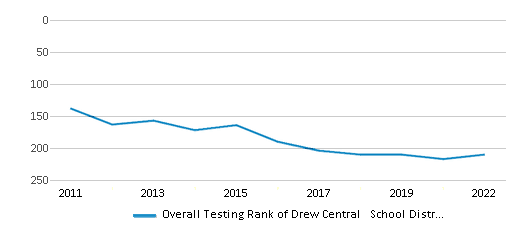
Math Test Scores (% Proficient)
23%
38%
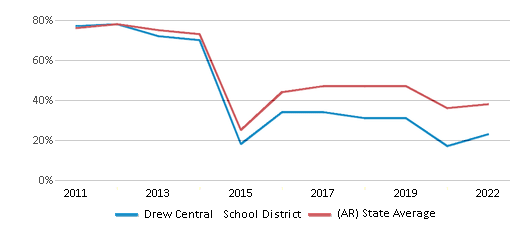
Reading/Language Arts Test Scores (% Proficient)
26%
40%
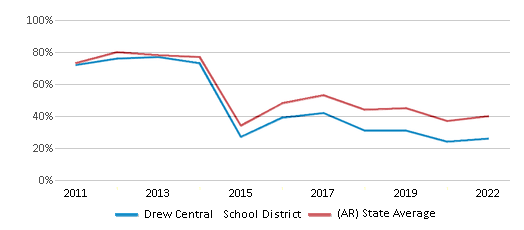
Science Test Scores (% Proficient)
25%
36%

Graduation Rate
85-89%
88%
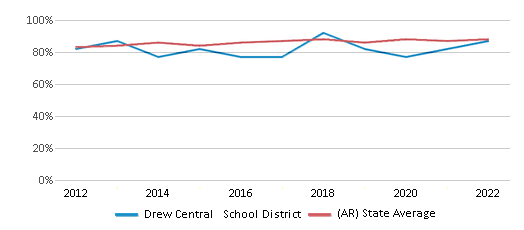
Students by Ethnicity:
Diversity Score
0.50
0.61
# American Indian Students
1 Student
1,684 Students
% American Indian Students
n/a
1%
# Asian Students
2 Students
5,542 Students
% Asian Students
n/a
2%
# Hispanic Students
65 Students
43,810 Students
% Hispanic Students
6%
15%
# Black Students
276 Students
58,360 Students
% Black Students
24%
19%
# White Students
772 Students
172,046 Students
% White Students
66%
57%
# Hawaiian Students
n/a
3,152 Students
% Hawaiian Students
n/a
1%
# Two or more races Students
45 Students
15,411 Students
% of Two or more races Students
4%
5%
Students by Grade:
# Students in PK Grade:
-
7,260
# Students in K Grade:
88
33,240
# Students in 1st Grade:
101
35,859
# Students in 2nd Grade:
90
37,037
# Students in 3rd Grade:
115
35,957
# Students in 4th Grade:
95
35,919
# Students in 5th Grade:
83
35,951
# Students in 6th Grade:
93
36,175
# Students in 7th Grade:
78
21,041
# Students in 8th Grade:
92
15,262
# Students in 9th Grade:
108
1,598
# Students in 10th Grade:
87
1,565
# Students in 11th Grade:
69
1,649
# Students in 12th Grade:
62
1,433
# Ungraded Students:
-
59
District Revenue and Spending
The revenue/student of $12,242 in this school district is less than the state median of $13,132. The school district revenue/student has stayed relatively flat over four school years.
The school district's spending/student of $11,087 is less than the state median of $13,043. The school district spending/student has stayed relatively flat over four school years.
Total Revenue
$14 MM
$6,371 MM
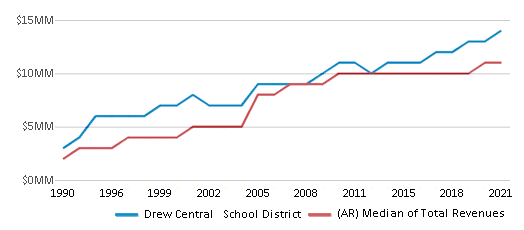
Spending
$13 MM
$6,327 MM
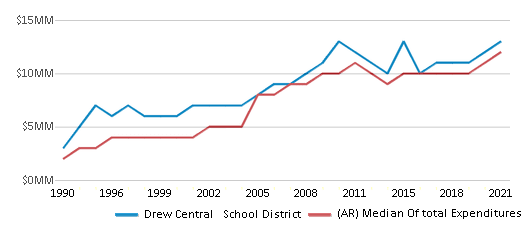
Revenue / Student
$12,242
$13,132

Spending / Student
$11,087
$13,043
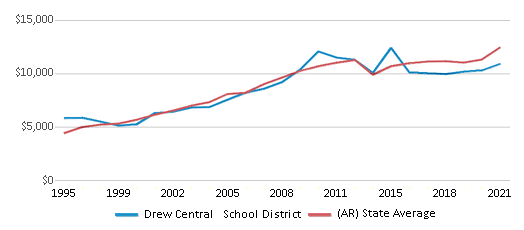
Best Drew Central School District Public Elementary Schools (2025)
School
(Math and Reading Proficiency)
(Math and Reading Proficiency)
Location
Grades
Students
Rank: #11.
Drew Central Middle School
(Math: 24% | Reading: 27%)
Rank:
Rank:
3/
Bottom 50%10
250 University Dr
Monticello, AR 71655
(870) 367-5235
Monticello, AR 71655
(870) 367-5235
Grades: 5-8
| 346 students
Rank: #22.
Drew Central Elem. School
(Math: 20-24% | Reading: 20-24%)
Rank:
Rank:
2/
Bottom 50%10
250 University Dr
Monticello, AR 71655
(870) 367-6893
Monticello, AR 71655
(870) 367-6893
Grades: K-4
| 489 students
Recent Articles

Year-Round Or Traditional Schedule?
Which is more appropriate for your child? A year-round attendance schedule or traditional schedule? We look at the pros and cons.

Why You Should Encourage Your Child to Join a Sports Team
Participating in team sports has a great many benefits for children, there is no doubt. In this article you will learn what those benefits are.

White Students are Now the Minority in U.S. Public Schools
Increasing birth rates among immigrant families from Asia and Central and South America, combined with lower birth rates among white families, means that for the first time in history, public school students in the United States are majority-minority. This shift in demographics poses difficulties for schools as they work to accommodate children of varying language abilities and socio-economic backgrounds.





